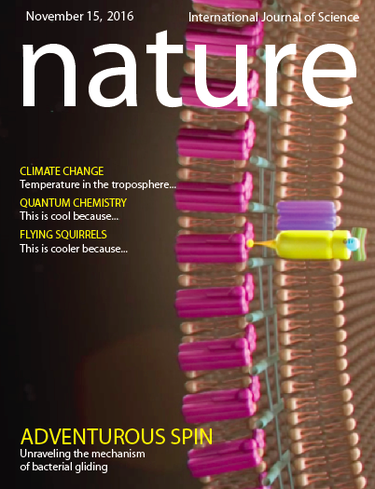Myxococcus aventourous gliding
The mechanism of force transmission at bacterial focal adhesion complexes
|
*Possibly a Nature cover.
|
Various rod-shaped bacteria mysteriously glide on surfaces in the absence of appendages such as flagella or pili. In the deltaproteobacterium Myxococcus xanthus, a putative gliding motility machinery (Agl–Glt) localizes to so-called Focal Adhesion sites (FA) that form stationary contact points with the underlying surface. We discovered that the Agl–Glt machinery contains an inner-membrane motor complex that moves intracellularly along a right-handed helical path, and when it becomes stationary at FA sites, it powers a left-handed rotation of the cell around its long axis. At FA sites, force transmission requires cyclic interactions between the molecular motor and adhesion proteins of the outer membrane via
a periplasmic interaction platform, which presumably involves a contractile activity of motor components and possible interactions with the peptidoglycan. This work provides the first molecular model for bacterial gliding motility. |
Varios tipos de bacteria son capaces de moverse sobre una superficie bi-dimensional en un proceso que no require apéndices de tipo flagela o pilus. En la bacteria Myxococcus xhantus, este proceso es energizado por una máquina molecular compuesta de dos complejos (Agl y Glt), y al menos 15 proteinas en total. Este complejo se auto-asambla en sitios de adhesion focal (SAF) que le proveen un punto de contacto con la superficie. En este estudio, descubrimos que la máquina Agl-Glt está compuesta de varios sub-complejos: un motor en la membrana interna, un complejo periplásmico, y un complejo externo. En ausencia de movimiento, el sub-complejo motor se mueve sobre la superficie de la célula siguiendo una trayectoria helicoidal. La fijación de este sub-complejo al punto de adhesion focal produce un torque/fuerza que mueve la célula en una trayectoria helicoidal (levógira). En estos sitios, la transmisión de fuerza requiere interacciones cíclicas entre el motor y proteinas de adhesion en el subcomplejo externo a través de interacciones que implican sub-unidades del complejo periplásmico. Estas últimas implican movimientos contráctiles del motor y posiblemente interacciones con el peptidoglycan. Este trabajo provee el primer modelo molecular del movimiento de desplazamiento de Myxococcus xhantus.
[1] The mechanism of force transmission at bacterial focal adhesion complexes.
L. Faure*, JB Fiche*, L Espinosa*, A Ducret, V Anantharaman, J Luciano, S Lhospice, S T. Islam, J Tréguier, M Sotes, E Kuru, M S. Van Nieuwenhze, Y Brun, O Théodoly, Aravind L, M Nollmann#, T Mignot#. [* co-authors] [#co-corresponding authors]
Nature, in press.
See also Tam's blog.
L. Faure*, JB Fiche*, L Espinosa*, A Ducret, V Anantharaman, J Luciano, S Lhospice, S T. Islam, J Tréguier, M Sotes, E Kuru, M S. Van Nieuwenhze, Y Brun, O Théodoly, Aravind L, M Nollmann#, T Mignot#. [* co-authors] [#co-corresponding authors]
Nature, in press.
See also Tam's blog.
